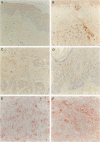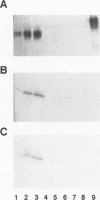Abstract
Melanocytic neoplasia is characterized by the aberrant overproduction of multiple cytokines in vitro. However, it is largely unknown how cytokine expression relates to melanoma progression in vivo. Transforming growth factor beta (TGF-beta) is a multifunctional cytokine commonly produced by cultured melanoma cells. The in situ expression of all three TGF-beta isoforms (TGF-beta1, -2, and -3) was determined immunohistochemically in melanocytes and in 51 melanocytic lesions using isoform-specific antibodies. Significant linear trends of expression were observed from melanocytes through nevi and primary and metastatic melanomas for all three isoforms. TGF-beta1 was expressed by some melanocytes and almost uniformly by nevi and melanomas. TGF-beta2 and -3 were not expressed in normal melanocytes but were expressed in nevi and early and advanced primary (radial and vertical growth phase) and metastatic melanomas in a tumor-progression-related manner. TGF-beta2 was heterogeneously expressed in advanced primary and metastatic melanomas, whereas TGF-beta3 was uniformly and highly expressed in these lesions. Thus, expression of TGF-beta isoforms in melanocytes and melanocytic lesions is heterogeneous and related to tumor progression, and expression of TGF-beta2 and TGF-beta3 commences at critical junctures during progression of nevi to primary melanomas.
Full text
PDF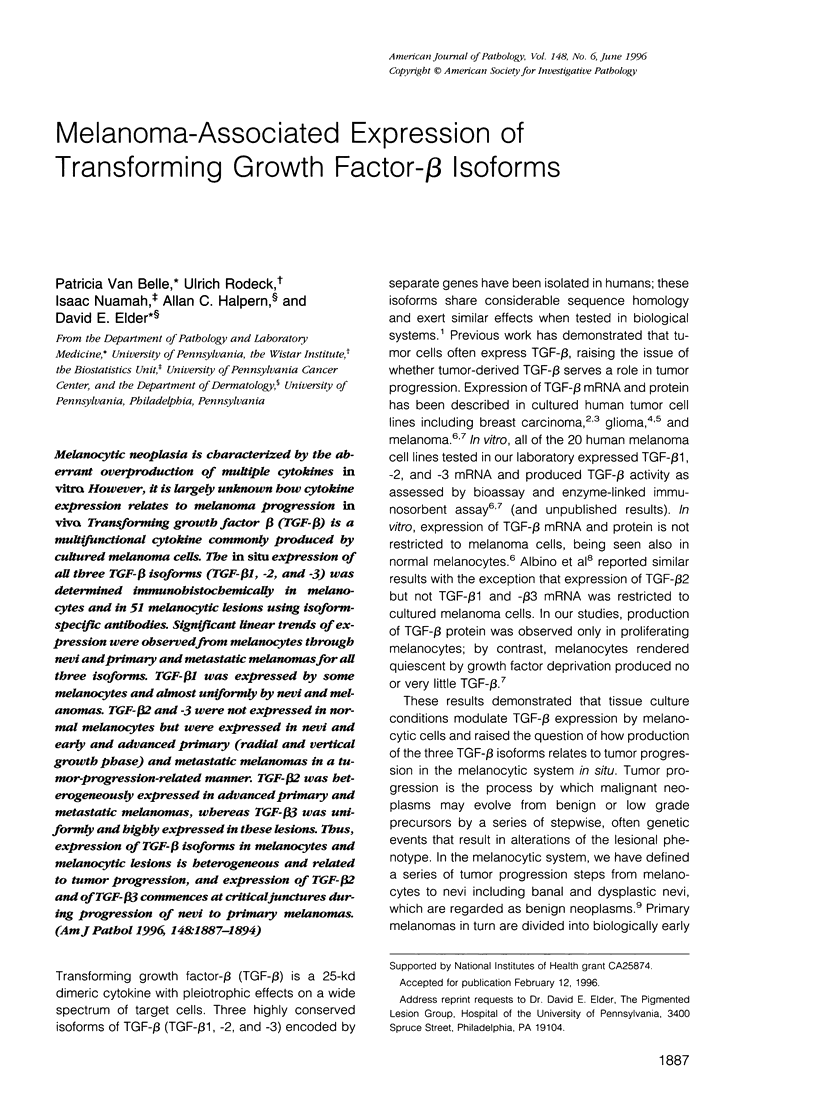
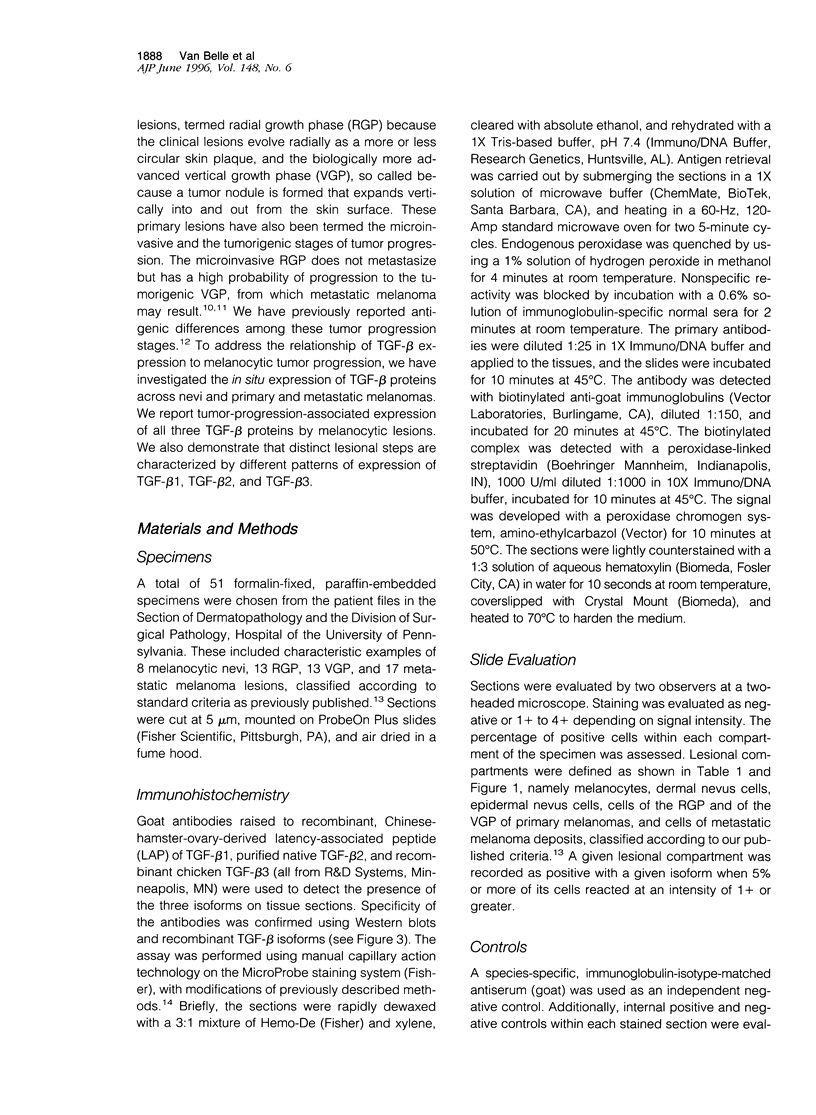
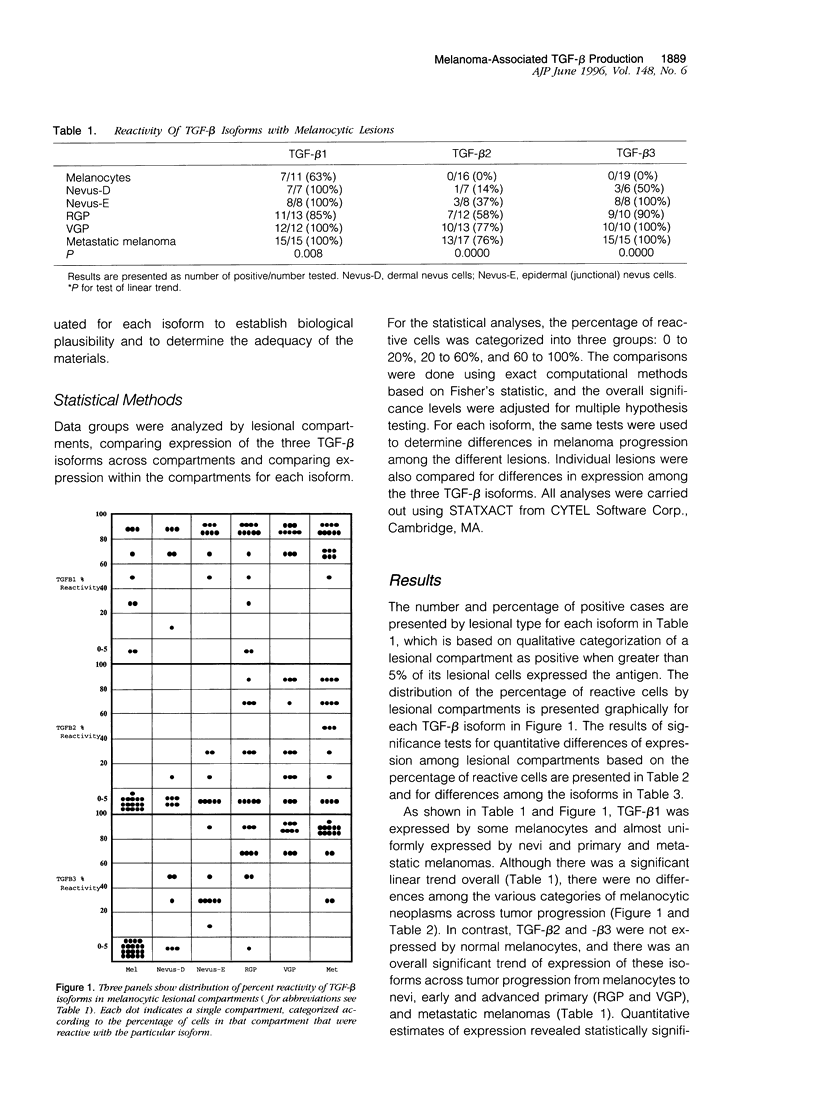
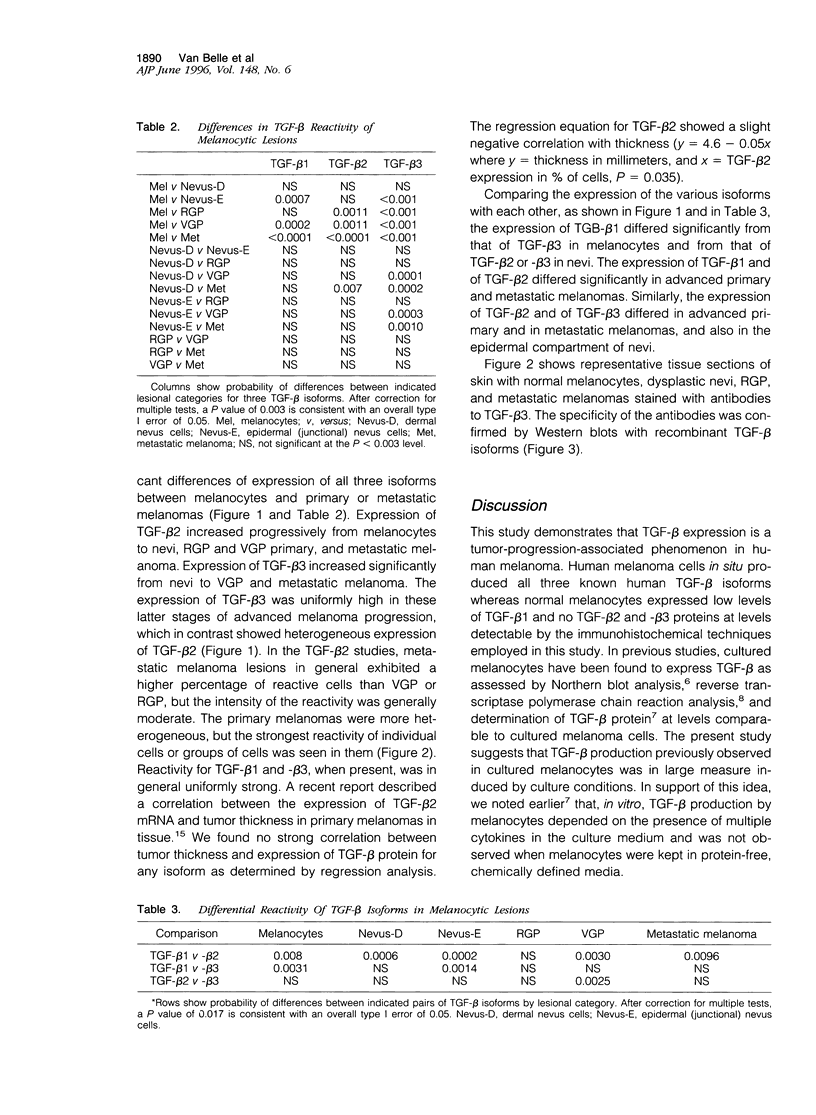
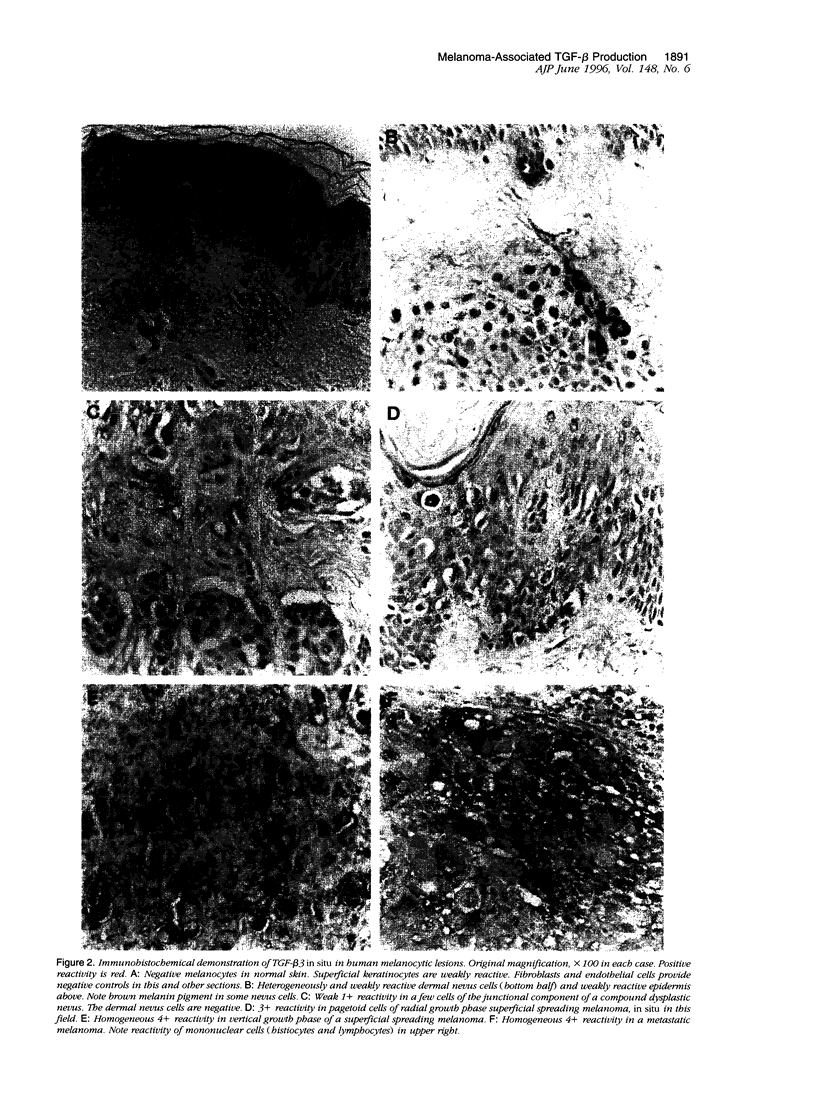
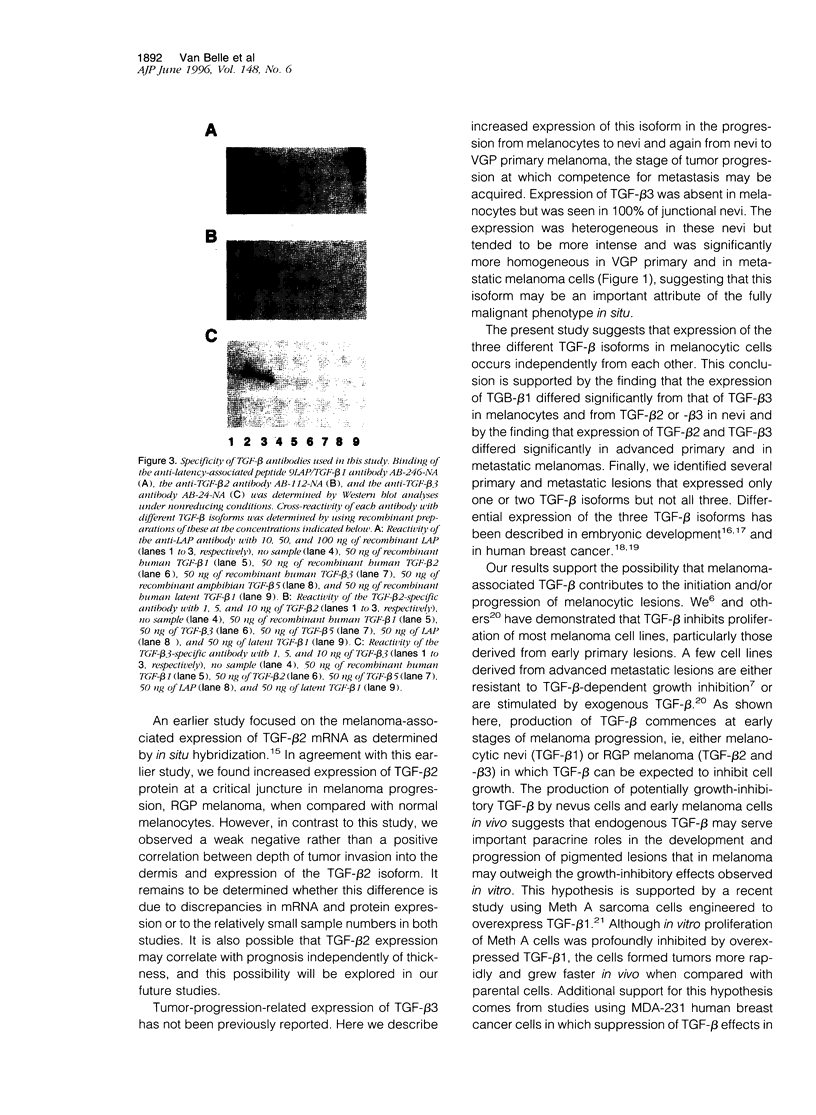
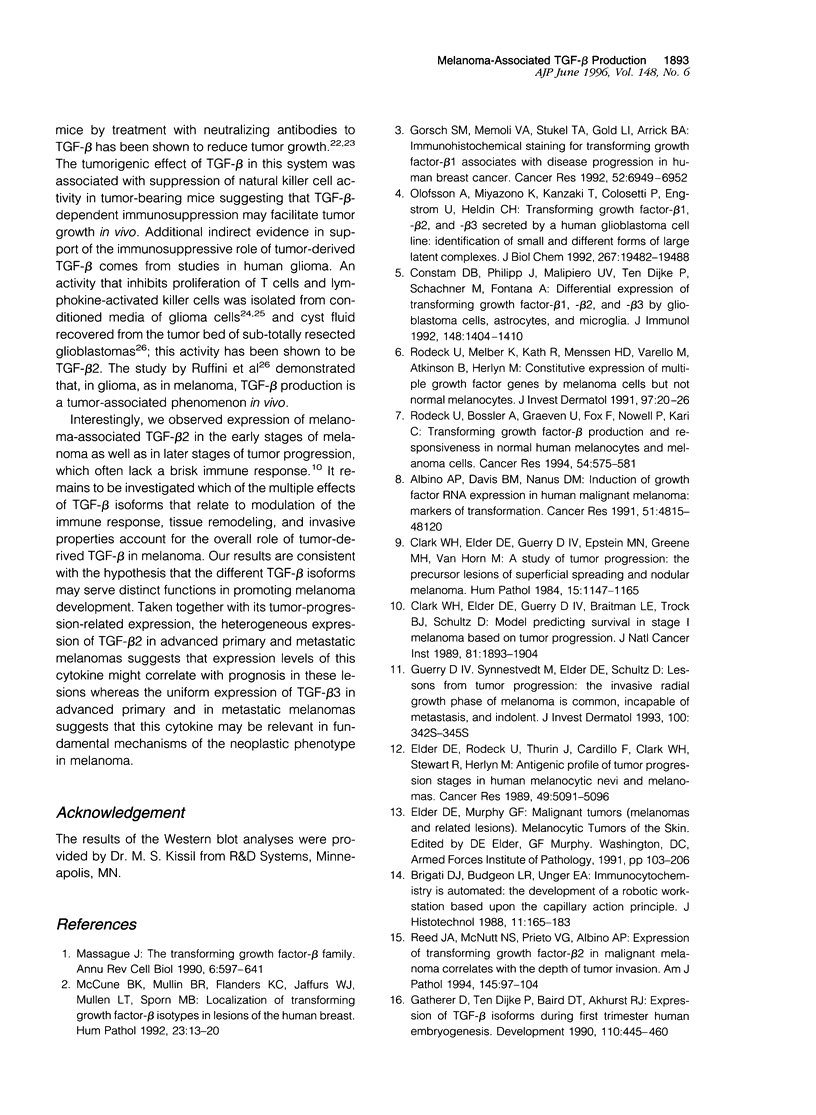
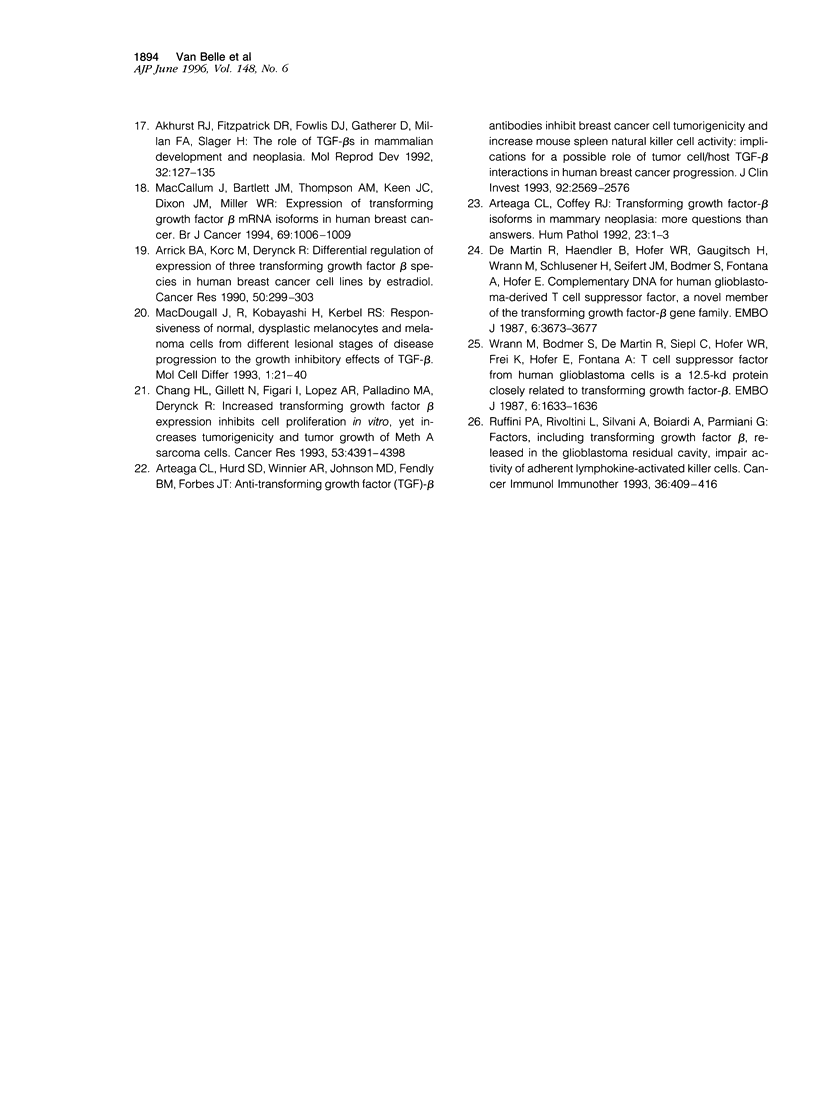
Images in this article
Selected References
These references are in PubMed. This may not be the complete list of references from this article.
- Akhurst R. J., Fitzpatrick D. R., Fowlis D. J., Gatherer D., Millan F. A., Slager H. The role of TGF-beta s in mammalian development and neoplasia. Mol Reprod Dev. 1992 Jun;32(2):127–135. doi: 10.1002/mrd.1080320208. [DOI] [PubMed] [Google Scholar]
- Albino A. P., Davis B. M., Nanus D. M. Induction of growth factor RNA expression in human malignant melanoma: markers of transformation. Cancer Res. 1991 Sep 15;51(18):4815–4820. [PubMed] [Google Scholar]
- Arrick B. A., Korc M., Derynck R. Differential regulation of expression of three transforming growth factor beta species in human breast cancer cell lines by estradiol. Cancer Res. 1990 Jan 15;50(2):299–303. [PubMed] [Google Scholar]
- Arteaga C. L., Coffey R. J. Transforming growth factor-beta isoforms in mammary neoplasia: more questions than answers. Hum Pathol. 1992 Jan;23(1):1–3. doi: 10.1016/0046-8177(92)90002-k. [DOI] [PubMed] [Google Scholar]
- Arteaga C. L., Hurd S. D., Winnier A. R., Johnson M. D., Fendly B. M., Forbes J. T. Anti-transforming growth factor (TGF)-beta antibodies inhibit breast cancer cell tumorigenicity and increase mouse spleen natural killer cell activity. Implications for a possible role of tumor cell/host TGF-beta interactions in human breast cancer progression. J Clin Invest. 1993 Dec;92(6):2569–2576. doi: 10.1172/JCI116871. [DOI] [PMC free article] [PubMed] [Google Scholar]
- Chang H. L., Gillett N., Figari I., Lopez A. R., Palladino M. A., Derynck R. Increased transforming growth factor beta expression inhibits cell proliferation in vitro, yet increases tumorigenicity and tumor growth of Meth A sarcoma cells. Cancer Res. 1993 Sep 15;53(18):4391–4398. [PubMed] [Google Scholar]
- Clark W. H., Jr, Elder D. E., Guerry D., 4th, Braitman L. E., Trock B. J., Schultz D., Synnestvedt M., Halpern A. C. Model predicting survival in stage I melanoma based on tumor progression. J Natl Cancer Inst. 1989 Dec 20;81(24):1893–1904. doi: 10.1093/jnci/81.24.1893. [DOI] [PubMed] [Google Scholar]
- Clark W. H., Jr, Elder D. E., Guerry D., 4th, Epstein M. N., Greene M. H., Van Horn M. A study of tumor progression: the precursor lesions of superficial spreading and nodular melanoma. Hum Pathol. 1984 Dec;15(12):1147–1165. doi: 10.1016/s0046-8177(84)80310-x. [DOI] [PubMed] [Google Scholar]
- Constam D. B., Philipp J., Malipiero U. V., ten Dijke P., Schachner M., Fontana A. Differential expression of transforming growth factor-beta 1, -beta 2, and -beta 3 by glioblastoma cells, astrocytes, and microglia. J Immunol. 1992 Mar 1;148(5):1404–1410. [PubMed] [Google Scholar]
- Elder D. E., Rodeck U., Thurin J., Cardillo F., Clark W. H., Stewart R., Herlyn M. Antigenic profile of tumor progression stages in human melanocytic nevi and melanomas. Cancer Res. 1989 Sep 15;49(18):5091–5096. [PubMed] [Google Scholar]
- Gatherer D., Ten Dijke P., Baird D. T., Akhurst R. J. Expression of TGF-beta isoforms during first trimester human embryogenesis. Development. 1990 Oct;110(2):445–460. doi: 10.1242/dev.110.2.445. [DOI] [PubMed] [Google Scholar]
- Gorsch S. M., Memoli V. A., Stukel T. A., Gold L. I., Arrick B. A. Immunohistochemical staining for transforming growth factor beta 1 associates with disease progression in human breast cancer. Cancer Res. 1992 Dec 15;52(24):6949–6952. [PubMed] [Google Scholar]
- Guerry D., 4th, Synnestvedt M., Elder D. E., Schultz D. Lessons from tumor progression: the invasive radial growth phase of melanoma is common, incapable of metastasis, and indolent. J Invest Dermatol. 1993 Mar;100(3):342S–345S. doi: 10.1111/1523-1747.ep12470248. [DOI] [PubMed] [Google Scholar]
- MacCallum J., Bartlett J. M., Thompson A. M., Keen J. C., Dixon J. M., Miller W. R. Expression of transforming growth factor beta mRNA isoforms in human breast cancer. Br J Cancer. 1994 Jun;69(6):1006–1009. doi: 10.1038/bjc.1994.197. [DOI] [PMC free article] [PubMed] [Google Scholar]
- Massagué J. The transforming growth factor-beta family. Annu Rev Cell Biol. 1990;6:597–641. doi: 10.1146/annurev.cb.06.110190.003121. [DOI] [PubMed] [Google Scholar]
- McCune B. K., Mullin B. R., Flanders K. C., Jaffurs W. J., Mullen L. T., Sporn M. B. Localization of transforming growth factor-beta isotypes in lesions of the human breast. Hum Pathol. 1992 Jan;23(1):13–20. doi: 10.1016/0046-8177(92)90004-m. [DOI] [PubMed] [Google Scholar]
- Olofsson A., Miyazono K., Kanzaki T., Colosetti P., Engström U., Heldin C. H. Transforming growth factor-beta 1, -beta 2, and -beta 3 secreted by a human glioblastoma cell line. Identification of small and different forms of large latent complexes. J Biol Chem. 1992 Sep 25;267(27):19482–19488. [PubMed] [Google Scholar]
- Reed J. A., McNutt N. S., Prieto V. G., Albino A. P. Expression of transforming growth factor-beta 2 in malignant melanoma correlates with the depth of tumor invasion. Implications for tumor progression. Am J Pathol. 1994 Jul;145(1):97–104. [PMC free article] [PubMed] [Google Scholar]
- Rodeck U., Bossler A., Graeven U., Fox F. E., Nowell P. C., Knabbe C., Kari C. Transforming growth factor beta production and responsiveness in normal human melanocytes and melanoma cells. Cancer Res. 1994 Jan 15;54(2):575–581. [PubMed] [Google Scholar]
- Rodeck U., Melber K., Kath R., Menssen H. D., Varello M., Atkinson B., Herlyn M. Constitutive expression of multiple growth factor genes by melanoma cells but not normal melanocytes. J Invest Dermatol. 1991 Jul;97(1):20–26. doi: 10.1111/1523-1747.ep12477822. [DOI] [PubMed] [Google Scholar]
- Ruffini P. A., Rivoltini L., Silvani A., Boiardi A., Parmiani G. Factors, including transforming growth factor beta, released in the glioblastoma residual cavity, impair activity of adherent lymphokine-activated killer cells. Cancer Immunol Immunother. 1993 Jun;36(6):409–416. doi: 10.1007/BF01742258. [DOI] [PMC free article] [PubMed] [Google Scholar]
- Wrann M., Bodmer S., de Martin R., Siepl C., Hofer-Warbinek R., Frei K., Hofer E., Fontana A. T cell suppressor factor from human glioblastoma cells is a 12.5-kd protein closely related to transforming growth factor-beta. EMBO J. 1987 Jun;6(6):1633–1636. doi: 10.1002/j.1460-2075.1987.tb02411.x. [DOI] [PMC free article] [PubMed] [Google Scholar]
- de Martin R., Haendler B., Hofer-Warbinek R., Gaugitsch H., Wrann M., Schlüsener H., Seifert J. M., Bodmer S., Fontana A., Hofer E. Complementary DNA for human glioblastoma-derived T cell suppressor factor, a novel member of the transforming growth factor-beta gene family. EMBO J. 1987 Dec 1;6(12):3673–3677. doi: 10.1002/j.1460-2075.1987.tb02700.x. [DOI] [PMC free article] [PubMed] [Google Scholar]



